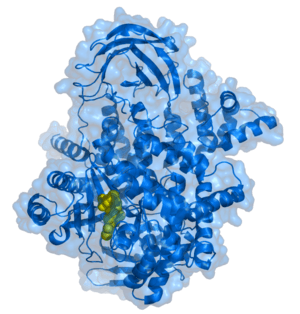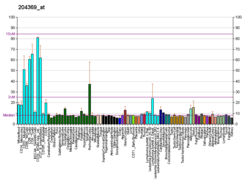P110α
The phosphatidylinositol-4,5-bisphosphate 3-kinase, catalytic subunit alpha (the HUGO-approved official symbol = PIK3CA; HGNC ID, HGNC:8975), also called p110α protein, is a class I PI 3-kinase catalytic subunit. The human p110α protein is encoded by the PIK3CA gene.[5]
Its role was uncovered by molecular pathological epidemiology (MPE).[6]
Function
Phosphatidylinositol-4,5-bisphosphate 3-kinase (also called phosphatidylinositol 3-kinase (PI3K)) is composed of an 85 kDa regulatory subunit and a 110 kDa catalytic subunit. The protein encoded by this gene represents the catalytic subunit, which uses ATP to phosphorylate phosphatidylinositols (PtdIns), PtdIns4P and PtdIns(4,5)P2.[7]
The involvement of p110α in human cancer has been hypothesized since 1995. Support for this hypothesis came from genetic and functional studies, including the discovery of common activating PIK3CA missense mutations in common human tumors.[8] It has been found to be oncogenic and is implicated in cervical cancers.[9] PIK3CA mutations are present in over one-third of breast cancers, with enrichment in the luminal and in human epidermal growth factor receptor 2-positive subtypes (HER2 +). The three hotspot mutation positions (GLU542, GLU545, and HIS1047) have been widely reported till date.[10] While substantial preclinical data show an association with robust activation of the pathway and resistance to common therapies, clinical data do not indicate that such mutations are associated with high levels of pathway activation or with a poor prognosis. It is unknown whether the mutation predicts increased sensitivity to agents targeting the P3K pathway.[11]
PIK3CA participates in a complex interaction within the tumor microenvironment in this phenomenon.[12]
Clinical characteristics
Due to the association between p110α and cancer,[13] it may be an appropriate drug target. Pharmaceutical companies are designing and characterizing potential p110α isoform specific inhibitors.[14][15]
The presence of [a] PIK3CA mutation may predict response to aspirin therapy for colorectal cancer.[16][17]
Somatic activating mutations in PIK3CA are found in Klippel-Trenaunay syndrome and venous malformation.[18][19]
PIK3CA-associated segmental overgrowth includes brain disorders such as macrocephaly-capillary malformation (MCAP) and hemimegalencephaly. It is also associated with congenital, lipomatous overgrowth of vascular malformations, epidermal nevi and skeletal/spinal anomalies (CLOVES syndrome) and fibroadipose hyperplasia (FH). The conditions are caused by heterozygous (usually somatic mosaic) mutations.[20]
Inhibition
All PI 3-kinases are inhibited by the drugs wortmannin and LY294002 but wortmannin shows better efficiency than LY294002 on the hotspot mutation positions.[21][22]
Pharmacology
In September 2017 Copanlisib, inhibiting predominantly p110α and p110δ, got FDA approval for the treatment of adult patients with relapsed follicular lymphoma (FL) who have received at least two prior systemic therapies.[23]
See also
- Phosphoinositide 3-kinase
- Phosphoinositide 3-kinase inhibitor
- PIK3CA-related overgrowth spectrum (PROS)
Interactions
P110α has been shown to interact with:
References
- GRCh38: Ensembl release 89: ENSG00000121879 - Ensembl, May 2017
- GRCm38: Ensembl release 89: ENSMUSG00000027665 - Ensembl, May 2017
- "Human PubMed Reference:". National Center for Biotechnology Information, U.S. National Library of Medicine.
- "Mouse PubMed Reference:". National Center for Biotechnology Information, U.S. National Library of Medicine.
- Hiles ID, Otsu M, Volinia S, Fry MJ, Gout I, Dhand R, Panayotou G, Ruiz-Larrea F, Thompson A, Totty NF (August 1992). "Phosphatidylinositol 3-kinase: structure and expression of the 110 kd catalytic subunit". Cell. 70 (3): 419–29. doi:10.1016/0092-8674(92)90166-A. PMID 1322797.
- Ogino S, Lochhead P, Giovannucci E, Meyerhardt JA, Fuchs CS, Chan AT (2013). "Discovery of colorectal cancer PIK3CA mutation as potential predictive biomarker: power and promise of molecular pathological epidemiology". Oncogene. 33 (23): 2949–2955. doi:10.1038/onc.2013.244. PMC 3818472. PMID 23792451.
- "Entrez Gene: PIK3CA".
- Samuels Y, Waldman T (2010-01-01). "Oncogenic mutations of PIK3CA in human cancers". In Rommel C, Vanhaesebroeck B, Vogt PK (eds.). Phosphoinositide 3-kinase in Health and Disease. Current Topics in Microbiology and Immunology. 347. Springer Berlin Heidelberg. pp. 21–41. doi:10.1007/82_2010_68. ISBN 9783642148156. PMC 3164550. PMID 20535651.
- Ma YY, Wei SJ, Lin YC, Lung JC, Chang TC, Whang-Peng J, Liu JM, Yang DM, Yang WK, Shen CY (May 2000). "PIK3CA as an oncogene in cervical cancer". Oncogene. 19 (23): 2739–44. doi:10.1038/sj.onc.1203597. PMID 10851074.
- Thirumal Kumar D, George Priya Doss C (September 2016). "Role of E542 and E545 missense mutations of PIK3CA in breast cancer: a comparative computational approach". Journal of Biomolecular Structure & Dynamics. 0 (12): 2745–2757. doi:10.1080/07391102.2016.1231082. PMID 27581627.
- Zardavas D, Phillips WA, Loi S (January 2014). "PIK3CA mutations in breast cancer: reconciling findings from preclinical and clinical data". Breast Cancer Research. 16 (1): 201. doi:10.1186/bcr3605. PMC 4054885. PMID 25192370.
- Fuchs CS, Ogino S (December 2013). "Aspirin therapy for colorectal cancer with PIK3CA mutation: simply complex!". Journal of Clinical Oncology. 31 (34): 4358–61. doi:10.1200/jco.2013.52.0080. PMID 24166520.
- Samuels Y, Wang Z, Bardelli A, Silliman N, Ptak J, Szabo S, Yan H, Gazdar A, Powell SM, Riggins GJ, Willson JK, Markowitz S, Kinzler KW, Vogelstein B, Velculescu VE (April 2004). "High frequency of mutations of the PIK3CA gene in human cancers". Science. 304 (5670): 554. doi:10.1126/science.1096502. PMID 15016963.
- Stein RC (September 2001). "Prospects for phosphoinositide 3-kinase inhibition as a cancer treatment". Endocrine-Related Cancer. Bioscientifica. 8 (3): 237–48. doi:10.1677/erc.0.0080237. PMID 11566615.
- Marone R, Cmiljanovic V, Giese B, Wymann MP (January 2008). "Targeting phosphoinositide 3-kinase: moving towards therapy". Biochimica et Biophysica Acta (BBA) - Proteins and Proteomics. 1784 (1): 159–85. doi:10.1016/j.bbapap.2007.10.003. PMID 17997386.
- Liao X, Lochhead P, Nishihara R, Morikawa T, Kuchiba A, Yamauchi M, Imamura Y, Qian ZR, Baba Y, Shima K, Sun R, Nosho K, Meyerhardt JA, Giovannucci E, Fuchs CS, Chan AT, Ogino S (October 2012). "Aspirin use, tumor PIK3CA mutation, and colorectal-cancer survival". The New England Journal of Medicine. 367 (17): 1596–606. doi:10.1056/nejmoa1207756. PMC 3532946. PMID 23094721.
- Domingo E, Church DN, Sieber O, Ramamoorthy R, Yanagisawa Y, Johnstone E, Davidson B, Kerr DJ, Tomlinson IP, Midgley R (December 2013). "Evaluation of PIK3CA mutation as a predictor of benefit from nonsteroidal anti-inflammatory drug therapy in colorectal cancer". Journal of Clinical Oncology. 31 (34): 4297–305. doi:10.1200/jco.2013.50.0322. PMID 24062397.
- Limaye N, Kangas J, Mendola A, Godfraind C, Schlögel MJ, Helaers R, Eklund L, Boon LM, Vikkula M (December 2015). "Somatic Activating PIK3CA Mutations Cause Venous Malformation". American Journal of Human Genetics. 97 (6): 914–21. doi:10.1016/j.ajhg.2015.11.011. PMC 4678782. PMID 26637981.
- Luks VL, Kamitaki N, Vivero MP, Uller W, Rab R, Bovée JV, Rialon KL, Guevara CJ, Alomari AI, Greene AK, Fishman SJ, Kozakewich HP, Maclellan RA, Mulliken JB, Rahbar R, Spencer SA, Trenor CC, Upton J, Zurakowski D, Perkins JA, Kirsh A, Bennett JT, Dobyns WB, Kurek KC, Warman ML, McCarroll SA, Murillo R (April 2015). "Lymphatic and other vascular malformative/overgrowth disorders are caused by somatic mutations in PIK3CA". The Journal of Pediatrics. 166 (4): 1048–54.e1–5. doi:10.1016/j.jpeds.2014.12.069. PMC 4498659. PMID 25681199.
- Mirzaa G, Conway R, Graham JM Jr, Dobyns WB (1993-01-01). Pagon RA, Adam MP, Ardinger HH, Wallace SE, Amemiya A, Bean LJ, Bird TD, Fong C, Mefford HC (eds.). "PIK3CA-Related Segmental Overgrowth". University of Washington, Seattle. PMID 23946963. Cite journal requires
|journal=(help) - Thirumal Kumar D, George Priya Doss C (September 2016). "Role of E542 and E545 missense mutations of PIK3CA in breast cancer: a comparative computational approach". Journal of Biomolecular Structure & Dynamics. 0 (12): 2745–2757. doi:10.1080/07391102.2016.1231082. PMID 27581627.
- Kumar DT, Doss CG (2016-01-01). "Investigating the Inhibitory Effect of Wortmannin in the Hotspot Mutation at Codon 1047 of PIK3CA Kinase Domain: A Molecular Docking and Molecular Dynamics Approach". Advances in Protein Chemistry and Structural Biology. 102: 267–97. doi:10.1016/bs.apcsb.2015.09.008. PMID 26827608.
- "FDA approves new treatment for adults with relapsed follicular lymphoma". US Food and Drug Administration. September 14, 2017.
- Holinstat M, Mehta D, Kozasa T, Minshall RD, Malik AB (August 2003). "Protein kinase Calpha-induced p115RhoGEF phosphorylation signals endothelial cytoskeletal rearrangement". The Journal of Biological Chemistry. 278 (31): 28793–8. doi:10.1074/jbc.M303900200. PMID 12754211.
- Zemlickova E, Dubois T, Kerai P, Clokie S, Cronshaw AD, Wakefield RI, Johannes FJ, Aitken A (August 2003). "Centaurin-alpha(1) associates with and is phosphorylated by isoforms of protein kinase C". Biochemical and Biophysical Research Communications. 307 (3): 459–65. doi:10.1016/s0006-291x(03)01187-2. PMID 12893243.
- Luo B, Prescott SM, Topham MK (October 2003). "Protein kinase C alpha phosphorylates and negatively regulates diacylglycerol kinase zeta". The Journal of Biological Chemistry. 278 (41): 39542–7. doi:10.1074/jbc.M307153200. PMID 12890670.
- Vargiu P, De Abajo R, Garcia-Ranea JA, Valencia A, Santisteban P, Crespo P, Bernal J (January 2004). "The small GTP-binding protein, Rhes, regulates signal transduction from G protein-coupled receptors". Oncogene. 23 (2): 559–68. doi:10.1038/sj.onc.1207161. PMID 14724584.
- Li W, Han M, Guan KL (April 2000). "The leucine-rich repeat protein SUR-8 enhances MAP kinase activation and forms a complex with Ras and Raf". Genes & Development. 14 (8): 895–900. PMC 316541. PMID 10783161.
- Rodriguez-Viciana P, Warne PH, Vanhaesebroeck B, Waterfield MD, Downward J (May 1996). "Activation of phosphoinositide 3-kinase by interaction with Ras and by point mutation". The EMBO Journal. 15 (10): 2442–51. doi:10.1002/j.1460-2075.1996.tb00602.x. PMC 450176. PMID 8665852.
- Sade H, Krishna S, Sarin A (January 2004). "The anti-apoptotic effect of Notch-1 requires p56lck-dependent, Akt/PKB-mediated signaling in T cells". The Journal of Biological Chemistry. 279 (4): 2937–44. doi:10.1074/jbc.M309924200. PMID 14583609.
- Prasad KV, Kapeller R, Janssen O, Repke H, Duke-Cohan JS, Cantley LC, Rudd CE (December 1993). "Phosphatidylinositol (PI) 3-kinase and PI 4-kinase binding to the CD4-p56lck complex: the p56lck SH3 domain binds to PI 3-kinase but not PI 4-kinase". Molecular and Cellular Biology. 13 (12): 7708–17. doi:10.1128/mcb.13.12.7708. PMC 364842. PMID 8246987.
Further reading
- Foster FM, Traer CJ, Abraham SM, Fry MJ (August 2003). "The phosphoinositide (PI) 3-kinase family". Journal of Cell Science. 116 (Pt 15): 3037–40. doi:10.1242/jcs.00609. PMID 12829733.
- Li VS, Wong CW, Chan TL, Chan AS, Zhao W, Chu KM, So S, Chen X, Yuen ST, Leung SY (March 2005). "Mutations of PIK3CA in gastric adenocarcinoma". BMC Cancer. 5: 29. doi:10.1186/1471-2407-5-29. PMC 1079799. PMID 15784156.
- Huang CH, Mandelker D, Schmidt-Kittler O, Samuels Y, Velculescu VE, Kinzler KW, Vogelstein B, Gabelli SB, Amzel LM (December 2007). "The structure of a human p110alpha/p85alpha complex elucidates the effects of oncogenic PI3Kalpha mutations". Science. 318 (5857): 1744–8. doi:10.1126/science.1150799. PMID 18079394.
- Pereira B, Chin SF, Rueda OM, Vollan HK, Provenzano E, Bardwell HA, Pugh M, Jones L, Russell R, Sammut SJ, Tsui DW, Liu B, Dawson SJ, Abraham J, Northen H, Peden JF, Mukherjee A, Turashvili G, Green AR, McKinney S, Oloumi A, Shah S, Rosenfeld N, Murphy L, Bentley DR, Ellis IO, Purushotham A, Pinder SE, Børresen-Dale AL, Earl HM, Pharoah PD, Ross MT, Aparicio S, Caldas C (May 2016). "The somatic mutation profiles of 2,433 breast cancers refines their genomic and transcriptomic landscapes". Nature Communications. 7: 11479. doi:10.1038/ncomms11479. PMC 4866047. PMID 27161491.





